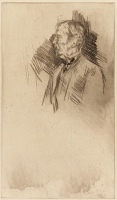Sir Garnet Wolseley | ||
| Number: | 177 | |
| Date: | 1877 | |
| Medium: | drypoint | |
| Size: | 305 x 177 mm | |
| Signed: | butterfly at left (5-final) | |
| Inscribed: | no | |
| Set/Publication: | no | |
| No. of States: | 7 | |
| Known impressions: | 7 | |
| Catalogues: | K.164; M.166; W.138 | |
| Impressions taken from this plate (7) | ||
TECHNIQUE
This is pure drypoint. There are what might be considered working proofs of the early states, some of which were extensively touched up with wash. According to Wedmore: 'Mr Menpes has an impression of this rare and vigorous sketch in dry-point, touched by Whistler in water colour.' 18 In this proof, there are touches of white gouache on the nose, cheek, moustache, beard and jaw ( ). Another working proof is touched with grey wash on the eyes, cheekbone, moustache, throat and back outline of the head, and there is a large curved area of wash from the eye to shoulder; and vertical strokes along the shoulder at right (
). Another working proof is touched with grey wash on the eyes, cheekbone, moustache, throat and back outline of the head, and there is a large curved area of wash from the eye to shoulder; and vertical strokes along the shoulder at right ( ).
).
 ). Another working proof is touched with grey wash on the eyes, cheekbone, moustache, throat and back outline of the head, and there is a large curved area of wash from the eye to shoulder; and vertical strokes along the shoulder at right (
). Another working proof is touched with grey wash on the eyes, cheekbone, moustache, throat and back outline of the head, and there is a large curved area of wash from the eye to shoulder; and vertical strokes along the shoulder at right ( ).
).18: Wedmore 1886 A (cat. no. 138).
PRINTING
Under ten impressions are known, most printed in black ink, although two late impressions are in dark brown ( ,
,  ). In printing, Whistler frequently used surface tone and fully inked lines to give a rich and dramatic effect. The drypoint lines were enriched by quite heavy, and sometimes uneven, tone in several impressions (i.e.
). In printing, Whistler frequently used surface tone and fully inked lines to give a rich and dramatic effect. The drypoint lines were enriched by quite heavy, and sometimes uneven, tone in several impressions (i.e.  ).
).
 ,
,  ). In printing, Whistler frequently used surface tone and fully inked lines to give a rich and dramatic effect. The drypoint lines were enriched by quite heavy, and sometimes uneven, tone in several impressions (i.e.
). In printing, Whistler frequently used surface tone and fully inked lines to give a rich and dramatic effect. The drypoint lines were enriched by quite heavy, and sometimes uneven, tone in several impressions (i.e.  ).
).Several impressions are printed on laid paper, the first state on cream laid 'antique' (pre-1800) paper with a 'Pro Patria' watermark ( ), and two (states 2 and 6) with an Arms of Amsterdam watermark (
), and two (states 2 and 6) with an Arms of Amsterdam watermark ( ,
,  ). The final impression, lightly printed in brown ink with little tone, was on ivory laid paper, trimmed and signed on the tab with a butterfly and 'imp.' to show that Whistler had printed it (
). The final impression, lightly printed in brown ink with little tone, was on ivory laid paper, trimmed and signed on the tab with a butterfly and 'imp.' to show that Whistler had printed it ( ). The signature dates from the 1890s, which may indicate that Whistler returned to the plate and printed it at that time, or just that he trimmed and signed it at that time. With one exception (
). The signature dates from the 1890s, which may indicate that Whistler returned to the plate and printed it at that time, or just that he trimmed and signed it at that time. With one exception ( ) - and this is not certain, because it has not been located - the earlier impressions are not trimmed.
) - and this is not certain, because it has not been located - the earlier impressions are not trimmed.
 ), and two (states 2 and 6) with an Arms of Amsterdam watermark (
), and two (states 2 and 6) with an Arms of Amsterdam watermark ( ,
,  ). The final impression, lightly printed in brown ink with little tone, was on ivory laid paper, trimmed and signed on the tab with a butterfly and 'imp.' to show that Whistler had printed it (
). The final impression, lightly printed in brown ink with little tone, was on ivory laid paper, trimmed and signed on the tab with a butterfly and 'imp.' to show that Whistler had printed it ( ). The signature dates from the 1890s, which may indicate that Whistler returned to the plate and printed it at that time, or just that he trimmed and signed it at that time. With one exception (
). The signature dates from the 1890s, which may indicate that Whistler returned to the plate and printed it at that time, or just that he trimmed and signed it at that time. With one exception ( ) - and this is not certain, because it has not been located - the earlier impressions are not trimmed.
) - and this is not certain, because it has not been located - the earlier impressions are not trimmed.
